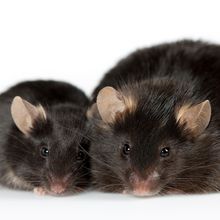virus

Viral Research Gets Batty to Study Spillovers
Shelby Bradford, PhD | Aug 5, 2024 | 3 min read
Marburg virus enters humans from bats to cause viral hemorrhagic fever, but how it alters immune cells is unclear.

How the Crimean Congo Virus Sneaks into Cells
Maggie Chen | Jul 15, 2024 | 4 min read
A tickborne virus uses cholesterol receptors to worm its way into the cell.

Engineered Rabies Virus Illuminates Neural Circuitry
Hannah Thomasy, PhD | Jun 14, 2024 | 10+ min read
Scientists turned a deadly virus into a crucial tool for understanding the wiring of the brain.

Viruses Keep Mice from Stressing Out
Shelby Bradford, PhD | May 9, 2024 | 3 min read
Gut viruses influence behavioral responses in mice and may be important players in the gut-brain axis.

Staying Ahead of Influenza
The Scientist Staff | May 1, 2024 | 2 min read
Researchers access a wide range of tools and reagents to keep pace with seasonal influenza.

Viral Immune Responses Suppress a Gestational Hormone
Shelby Bradford, PhD | Mar 25, 2024 | 4 min read
Influenza infection activates a pathway that leads to a detrimental drop in progesterone during pregnancy in mice.

Bat Immune Systems: The Original Antivirus Programs
Hannah Thomasy, PhD | Mar 15, 2024 | 3 min read
Bats stay healthy while hosting some of the world’s deadliest viruses. Scientists are just beginning to understand how.

New Strategies in the Battle Against Infectious Diseases
The Scientist Staff | Jan 8, 2024 | 2 min read
Learn how the latest research into viral and bacterial pathogens advances the prevention and treatment of infectious diseases.

qPCR: Driving Wastewater Surveillance for Infectious Disease
Nathan Ni, PhD | Oct 30, 2023 | 3 min read
Natalie Knox and the Public Health Agency of Canada’s National Microbiology Laboratory are helping establish a national qPCR-driven wastewater surveillance network for SARS-CoV-2 and other diseases.

What Could Cause the Next Pandemic?
The Scientist | Mar 15, 2023 | 2 min read
Scientists prepare for the future by filling in the research gaps between zoonotic viral reservoirs, emerging viruses, and human immune defenses.

Viral Vector Platforms for Gene Therapy
The Scientist | Feb 9, 2023 | 1 min read
In both the laboratory and clinic, scientists harness viral genetic transfer capabilities to develop gene therapies that modulate cellular function.

“Origami” DNA Traps Could Keep Large Viruses From Infecting Cells
Natalia Mesa, PhD | Jan 18, 2023 | 4 min read
By engineering structures out of DNA, scientists could potentially prevent larger viruses, like coronaviruses and influenza viruses, from interacting with cells.

Monir Moniruzzaman Studies the Secrets of Giant Viruses
James M. Gaines | Jan 2, 2023 | 4 min read
The University of Miami researcher studies how a mysterious group of supersized viruses infects and influences the evolution of their hosts.

What Happens When You Catch More than One Virus?
Alejandra Manjarrez, PhD | Dec 7, 2022 | 8 min read
The “tripledemic” shines a spotlight on viral interference, in which one infection can block another.

Recently Discovered Virus Family Infects a Human Oral Amoeba
Alejandra Manjarrez, PhD | Dec 1, 2022 | 3 min read
Redondoviruses, which have been associated with cases of periodontitis and other diseases, turn out to live inside the amoeba Entamoeba gingivalis.

Duplicated Gene Helps Bats Survive “Arms Race” With Viruses
Dan Robitzski | Nov 23, 2022 | 5 min read
Bats are known for staying healthy even while harboring viral infections. Now, research sheds light on how their unusual immune system evolved.

Scientists ID Heart-Damaging SARS-CoV-2 Protein
Grace van Deelen | Nov 22, 2022 | 3 min read
In flies and mice, a viral protein increases the rate of energy use by heart cells. But it’s not yet clear if the finding applies to humans.

Obesity Protects Against Genital Herpes in Mice, Study Finds
Katherine Irving | Nov 11, 2022 | 3 min read
A high-fat diet induced changes to the animals’ vaginal microbiomes that boosted survival after exposure to the virus.

Brush Up: Quorum Sensing in Bacteria and Beyond
Deanna MacNeil, PhD | Nov 1, 2022 | 4 min read
Microbes communicate with quorum sensing to coordinate their behavior in response to how many neighbors they have.
